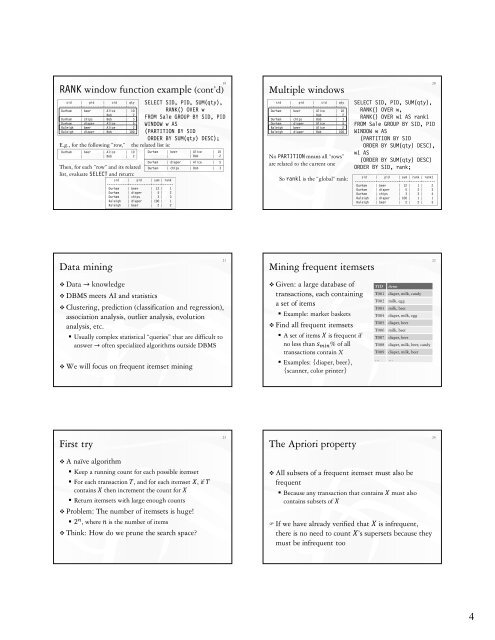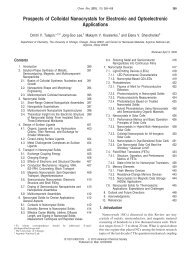Data Warehousing and Data Mining Announcements (Tue. Dec. 3 ...
Data Warehousing and Data Mining Announcements (Tue. Dec. 3 ...
Data Warehousing and Data Mining Announcements (Tue. Dec. 3 ...
Create successful ePaper yourself
Turn your PDF publications into a flip-book with our unique Google optimized e-Paper software.
RANK window function example (cont’d) 19<br />
sid | pid | cid | qty<br />
------------+------------+------------+-----<br />
Durham | beer | Alice | 10<br />
| | Bob | 2<br />
Durham | chips | Bob | 3<br />
Durham | diaper | Alice | 5<br />
Raleigh | beer | Alice | 2<br />
Raleigh | diaper | Bob | 100<br />
E.g., for the following “row,”<br />
Durham | beer | Alice | 10<br />
| | Bob | 2<br />
Then, for each “row” <strong>and</strong> its related<br />
list, evaluate SELECT <strong>and</strong> return:<br />
SELECT SID, PID, SUM(qty),<br />
RANK() OVER w<br />
FROM Sale GROUP BY SID, PID<br />
WINDOW w AS<br />
(PARTITION BY SID<br />
ORDER BY SUM(qty) DESC);<br />
the related list is:<br />
sid | pid | sum | rank<br />
------------+------------+-----+------<br />
Durham | beer | 12 | 1<br />
Durham | diaper | 5 | 2<br />
Durham | chips | 3 | 3<br />
Raleigh | diaper | 100 | 1<br />
Raleigh | beer | 2 | 2<br />
Durham | beer | Alice | 10<br />
| | Bob | 2<br />
Durham | diaper | Alice | 5<br />
Durham | chips | Bob | 3<br />
Multiple windows<br />
sid | pid | cid | qty<br />
------------+------------+------------+-----<br />
Durham | beer | Alice | 10<br />
| | Bob | 2<br />
Durham | chips | Bob | 3<br />
Durham | diaper | Alice | 5<br />
Raleigh | beer | Alice | 2<br />
Raleigh | diaper | Bob | 100<br />
No PARTITION means all “rows”<br />
are related to the current one<br />
So rank1 is the “global” rank:<br />
SELECT SID, PID, SUM(qty),<br />
RANK() OVER w,<br />
RANK() OVER w1 AS rank1<br />
FROM Sale GROUP BY SID, PID<br />
WINDOW w AS<br />
(PARTITION BY SID<br />
ORDER BY SUM(qty) DESC),<br />
w1 AS<br />
(ORDER BY SUM(qty) DESC)<br />
ORDER BY SID, rank;<br />
sid | pid | sum | rank | rank1<br />
------------+------------+-----+------+-------<br />
Durham | beer | 12 | 1 | 2<br />
Durham | diaper | 5 | 2 | 3<br />
Durham | chips | 3 | 3 | 4<br />
Raleigh | diaper | 100 | 1 | 1<br />
Raleigh | beer | 2 | 2 | 5<br />
20<br />
<strong>Data</strong> mining<br />
21<br />
<strong>Mining</strong> frequent itemsets<br />
22<br />
<strong>Data</strong> → knowledge<br />
DBMS meets AI <strong>and</strong> statistics<br />
Clustering, prediction (classification <strong>and</strong> regression),<br />
association analysis, outlier analysis, evolution<br />
analysis, etc.<br />
Usually complex statistical “queries” that are difficult to<br />
answer → often specialized algorithms outside DBMS<br />
We will focus on frequent itemset mining<br />
Given: a large database of<br />
transactions, each containing<br />
a set of items<br />
Example: market baskets<br />
Find all frequent itemsets<br />
A set of items is frequent if<br />
no less than % of all<br />
transactions contain X<br />
Examples: {diaper, beer},<br />
{scanner, color printer}<br />
TID<br />
T001<br />
T002<br />
T003<br />
T004<br />
T005<br />
T006<br />
T007<br />
T008<br />
T009<br />
…<br />
items<br />
diaper, milk, c<strong>and</strong>y<br />
milk, egg<br />
milk, beer<br />
diaper, milk, egg<br />
diaper, beer<br />
milk, beer<br />
diaper, beer<br />
diaper, milk, beer, c<strong>and</strong>y<br />
diaper, milk, beer<br />
…<br />
First try<br />
23<br />
The Apriori property<br />
24<br />
A naïve algorithm<br />
Keep a running count for each possible itemset<br />
For each transaction , <strong>and</strong> for each itemset , if <br />
contains then increment the count for <br />
Return itemsets with large enough counts<br />
Problem: The number of itemsets is huge!<br />
2 , where is the number of items<br />
Think: How do we prune the search space?<br />
All subsets of a frequent itemset must also be<br />
frequent<br />
Because any transaction that contains must also<br />
contains subsets of <br />
If we have already verified that is infrequent,<br />
there is no need to count ’s supersets because they<br />
must be infrequent too<br />
4
















